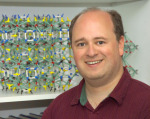54 nets and nothing fishy
Prof. Batten tells a tale of why it's always healthy to be skeptical!
What is it?
One of the most important qualities of a scientist is scepticism. The predisposition to doubt conclusions without solid supporting evidence is vital. Nowhere does this apply more than to your own work.
So when one of my colleagues requested my help with a structure that they thought contained 54 interpenetrating three-dimensional networks my initial reaction was that, in polite terms, they'd made a mistake somewhere and I'd need to find it. Yes, interpenetration of networks is quite common in framework structures – see, for example, the two interpenetrating diamond nets in the structures of zinc cyanide and cadmium cyanide, discussed previously on this blog. But the previous 'record' was only 18 nets, an exceptional number in itself. This was three times that – there was no way that so many independent 3D networks could pass through each other without bumping into themselves, never mind the incredible self-assembly process that must happen for such a structure to form. It simply defied belief.
I was wrong.
The structure did, of course, contain 54 interpenetrating, independent networks. Each network was composed of silver atoms bridged by tri(4-imidazolylphenyl)amine ligands. The ligands bridged in two different ways – one was bound to three metals, while the other coordinated to only two. Furthermore, all the silver atoms connected to only two ligands, meaning that the branching points of the networks, the centres of the 3-connecting ligands, were interconnected by parts of two 3-connecting ligands, pairs of silver atoms, and a 2-connecting ligand. As the ligands themselves were quite large, the nodes were therefore an enormous 36.85 Å apart. This very large distance between the nodes meant that an individual net was extremely spacious, and gave the necessary room for 53 other networks to form and entangle with the first. So a few hours and one headache later I found myself confirming that yes, the structure did indeed have that many unconnected networks all tangled up together.
Another interesting feature of this structure was that the networks formed had the "(10,3)-a" topology. This network is of particular interest because it is chiral – i.e. there are two different versions of the net that are mirror images of each other (in the same way that your left and right hands are mirror images and different). Remarkably, nets of both "handedness" were present in this structure – 27 of each – to give an arrangement that was overall nonchiral (or racemic – see the tartaric acid blog post for an explanation of this applied to discrete molecules rather than infinite networks).
What does it look like?
Two of the 54 interpenetrating networks are shown schematically in the figure. Although distorted from the most symmetrical version of the (10,3)-a topology, the chirality of the nets can be seen in the rectangular spirals. Those of the blue net spiral into the page in an anti-clockwise fashion, while those of the red net spiral into the page in a clockwise fashion. The real structure, of course, squeezes another 52 nets into the space you see here.
Where did the structure come from?
"An Exceptional 54-Fold Interpenetrated Coordination Polymer with 103-srs Network Topology", H. Wu, J. Yang, Z.-M. Su, S.R. Batten and J.-F. Ma, J. Am. Chem. Soc. (2011), 133, 11406-11409. DOI: dx.doi.org/10.1021/ja202303b
CCDC Refcode: OYEYOH







